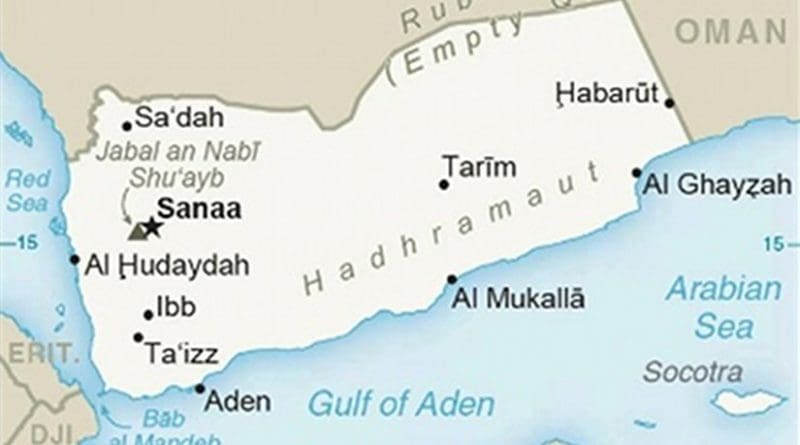Yemen: Saudi Arabia Using US Cluster Munitions, Says HRW
Saudi Arabia has used US-made cluster munitions near civilian areas in Yemen, leaving behind unexploded submunitions, Human Rights Watch said Friday, adding the United States should cease its production and transfer of cluster munitions to conform with the widely accepted international ban on the weapons.
US export rules that rely on weapon reliability standards have not prevented the sale of cluster munitions to Saudi Arabia, putting civilians at long-term risk, Human Rights Watch said. Cluster munitions are prohibited by a 2008 treaty signed by 119 countries, though not Saudi Arabia, Yemen, or the US.
“The US has sold Saudi Arabia cluster munitions, a weapon most countries have rejected due to the harm they cause civilians,” said Steve Goose, arms director at Human Rights Watch and chair of the Cluster Munition Coalition, the international coalition of groups working to eradicate cluster munitions. “Saudi Arabia should stop using cluster munitions in Yemen or anywhere else, and the US should stop producing and exporting them.”
Since March 26, 2015, a Saudi Arabia-led coalition of nine Arab states has conducted a military operation in Yemen against Houthi forces, also known as Ansar Allah. A ceasefire that came into force on April 10, 2016, has been repeatedly violated by all sides.
In the past year, Human Rights Watch has documented civilian casualties in Yemen from the Saudi Arabia-led coalition’s use of four types of US-made air-dropped and ground-launched cluster munitions. This includes using CBU-105 Sensor Fuzed Weapons in at least six airstrikes in the governorates of Amran, Hodaida, Saada, and Sanaa. The most recent CBU-105 attack was recorded on February 15, at a cement factory in Amran governornate.
Cluster munitions are dropped from aircraft or delivered from the ground by artillery and rockets, and contain multiple smaller submunitions or bomblets. Cluster munitions pose an immediate threat to civilians as they disperse over a wide area and leave explosive remnants, including submunitions that fail to explode upon impact and become de facto landmines.
US export law provisions from December 2007 prohibit recipients of US cluster munitions from using them in populated areas and permit the transfer only of cluster munitions with a failure rate of less than 1 percent. Cluster munitions transferred before then are not covered by these requirements.
Saudi Arabia and the United Arab Emirates (UAE) have both received CBU-105 Sensor Fuzed Weapons from the US in recent years. There is no evidence to indicate that other countries in the Saudi-led coalition – Bahrain, Egypt, Jordan, Kuwait, Morocco, Qatar, and Sudan – have received CBU-105 Sensor Fuzed Weapons. The US also provided Saudi Arabia with significant exports of other cluster bombs between 1970 and 1999.
According to a data sheet issued by its manufacturer, Textron Systems Corporation, each CBU-105 disperses 10 BLU-108 canisters that each subsequently release four submunitions the company calls “skeet” that are designed to sense, classify, and engage a target such as an armored vehicle. They are designed to explode above the ground and project an explosively formed jet of metal and fragmentation downward. The submunitions of the Sensor Fuzed Weapon are equipped with electronic self-destruct and self-deactivation features.
However, Human Rights Watch field research and visual evidence indicate at least three attacks that resulted in multiple BLU-108 with their “skeet” or submunitions still attached: in the governorates of Amran on February 15, 2016; Sanaa on May 21, 2015; and Saada on April 27, 2015. This shows a failure to function as intended, as the submunitions failed to disperse from the canister, or were dispersed but did not explode. In May 2011, guidance issued by the US Defense Security Cooperation Agency stated that skeet from CBU-105 Sensor Fuzed Weapon are “the only cluster munition with a compliant submunition” with US export rules.
The Sensor Fuzed Weapons have been used in or near civilian areas, also in apparent violation of US export law. A woman and two children were injured in their homes by CBU-105 Sensor Fuzed Weapons used on December 12, 2015, on the port town of Hodaida, while at least two civilians were wounded in an attack that used CBU-105 Sensor Fuzed Weapons near al-Amar village in Saada governorate on April 27, 2015.
Saudi Arabia has repeatedly denied using other types of cluster munitions in Yemen, but it has admitted using CBU-105 Sensor Fuzed Weapons once, in April 2015.
The UAE acknowledges stockpiling CBU-105 Sensor Fuzed Weapons, but denies using them in Yemen. On April 12, 2016, a diplomatic representative of the UAE told the Cluster Munition Coalition that the UAE is not using CBU-105 Sensor Fuzed Weapons because they are banned by the 2008 Convention on Cluster Munitions.
“Following multiple attacks in Yemen, it is now obvious that Sensor Fuzed Weapons are not the ‘reliable’ or ‘intelligent’ cluster munitions they have been promoted as,” Goose said. “The US should cease production and transfer of these weapons following the evidence of their failures and their use in and near civilian areas and should join the international ban on cluster munitions.”

